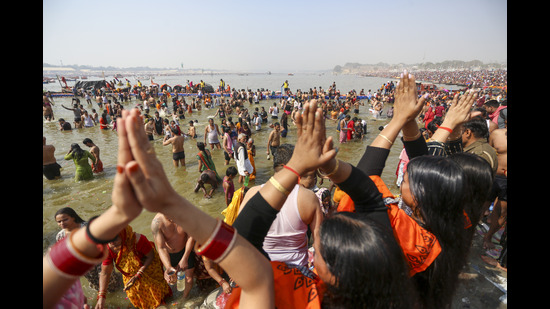Ensuring a clean Maha Kumbh
Pollution in the Ganga at the Sangam needs to be addressed with the help of science. Ignoring it will have consequences for public health
For millennia, the Ganga has been a metaphor for purity for the faithful in India. Almost as a corollary, conversations around its pollution and conservation are marked by either concern -- among policymakers, civil society and activists -- regarding the problem or the nonchalance of the millions whose piety impels them to taking a dip in its waters at various designated sites, round the year. The Kumbh/Maha Kumbhs only add to this dichotomy.

Now a row has erupted over water quality at Sangam in Prayagraj, the site for ritual bathing during the Maha Kumbh. On Wednesday, Uttar Pradesh (UP) chief minister Yogi Adityanath declared the water at Sangam fit for ritual drinking just days after the National Green Tribunal (NGT)’s stinging censure of the UP Pollution Control Board (UPPCB) for failing to act on the February 3 report of the Central Pollution Control Board (CPCB) and allowing millions thronging to the Maha Kumbh to bathe in severely polluted waters. The CPCB report flagged samples from the site, taken on different dates in January after the Maha Kumbh began, as unfit for outdoor organised bathing. Faecal coliform presence -- a key metric of water pollution -- at a most probable number (MPN) of 49,000 per 100 ml was close to 20 times the tolerable limit of 2,500 MPN per 100 ml for bathing; the desirable limit, according to CPCB was 500 MPN per 100 ml. Adityanath termed this “false propaganda” designed to mislead people. He cited UPPCB data showing biochemical oxygen demand and faecal coliform presence to be within tolerable limits.
But it transpires that UPPCB’s data pre-dates the Maha Kumbh; NGT has criticised the body for submitting old data before it. The state body then assured the tribunal that fresh samples will be evaluated and an action-taken report submitted within a week. This is important. High bacterial presence in the water at Sangam can have grave consequences for public health. The two pollution regulators, CPCB and UPPCB, and NGT, must now clear the air. Given the metrics of water pollution are all clearly defined, it shouldn’t be too difficult.
The faithful have a right to bathe at Sangam. And the state has a responsibility to ensure that the water is fit enough to do so – data and science (and not faith, however) should be the tools it uses.
All Access.
One Subscription.
Get 360° coverage—from daily headlines
to 100 year archives.



HT App & Website







